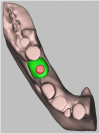Computer-aided design/computer-aided manufacturing of hydroxyapatite scaffolds for bone reconstruction in jawbone atrophy: a systematic review and case report
- PMID: 26767187
- PMCID: PMC4700069
- DOI: 10.1186/s40902-015-0048-7
Computer-aided design/computer-aided manufacturing of hydroxyapatite scaffolds for bone reconstruction in jawbone atrophy: a systematic review and case report
Abstract
Background: We reviewed the biological and mechanical properties of porous hydroxyapatite (HA) compared to other synthetic materials. Computer-aided design/computer-aided manufacturing (CAD/CAM) was also evaluated to estimate its efficacy with clinical and radiological assessments.
Method: A systematic search of the electronic literature database of the National Library of Medicine (PubMed-MEDLINE) was performed for articles published in English between January 1985 and September 2013. The inclusion criteria were (1) histological evaluation of the biocompatibility and osteoconductivity of porous HA in vivo and in vitro, (2) evaluation of the mechanical properties of HA in relation to its porosity, (3) comparison of the biological and mechanical properties between several biomaterials, and (4) clinical and radiological evaluation of the precision of CAD/CAM techniques.
Results: HA had excellent osteoconductivity and biocompatibility in vitro and in vivo compared to other biomaterials. HA grafts are suitable for milling and finishing, depending on the design. In computed tomography, porous HA is a more resorbable and more osteoconductive material than dense HA; however, its strength decreases exponentially with an increase in porosity.
Conclusions: Mechanical tests showed that HA scaffolds with pore diameters ranging from 400 to 1200 μm had compressive moduli and strength within the range of the human craniofacial trabecular bone. In conclusion, using CAD/CAM techniques for preparing HA scaffolds may increase graft stability and reduce surgical operating time.
Keywords: Computer-aided design/computer-aided manufacturing; Hydroxyapatite; Review; Scaffold.
Figures

















References
-
- Kim MK, Park YT, Kim SG, Park YW, Lee SK, Choi WS. The effect of a hydroxyapatite and 4-hexylresorcinol combination graft on bone regeneration in the rabbit calvarial defect model. J Korean Assoc Maxillofac Plast Reconstr Surg. 2012;34:377–83.
-
- Maiorana C, Beretta M, Salina S, Santoro F. Reduction of autogenous bone graft resorption by means of bio-oss coverage: a prospective study. Int J Periodontics Restorative Dent. 2005;25:19–25. - PubMed
-
- Szabó G, Huys L, Coulthard P, Maiorana C, Garagiola U, Barabás J, et al. A prospective multicenter randomized clinical trial of autogenous bone versus beta-tricalcium phosphate graft alone for bilateral sinus elevation: histologic and histomorphometric evaluation. Int J Oral Maxillofac Implants. 2005;20:371–81. - PubMed
-
- Suba Z, Hrabák K, Coulthard P, Maiorana C, Garagiola U, Szabó G, et al. Histologic and histomorphometric study of bone regeneration induced by beta-tricalcium phosphate (multicenter study) Orv Hetil. 2004;145:1431–7. - PubMed
Publication types
LinkOut - more resources
Full Text Sources
Other Literature Sources
Miscellaneous
